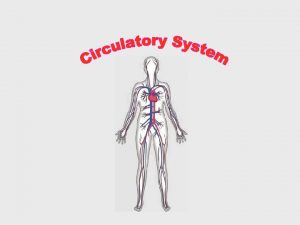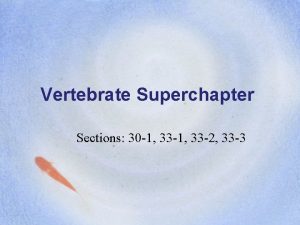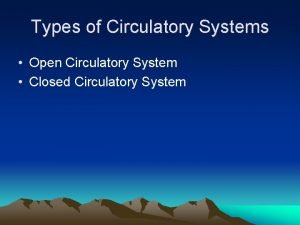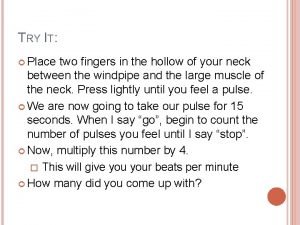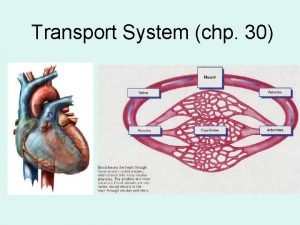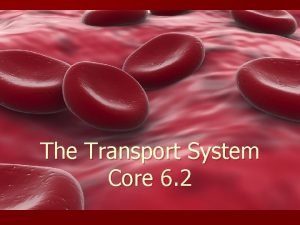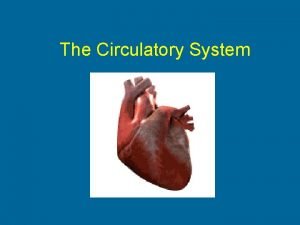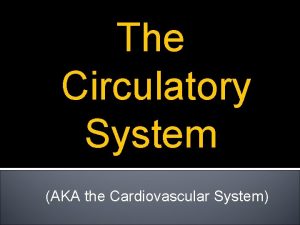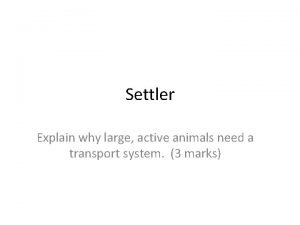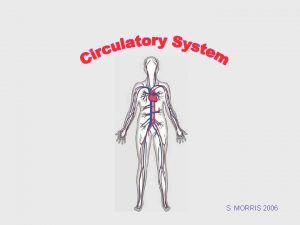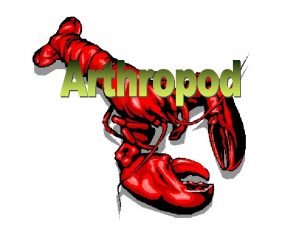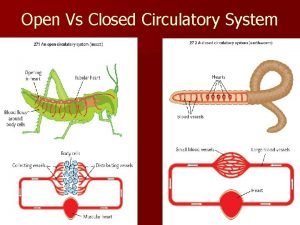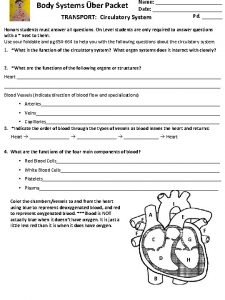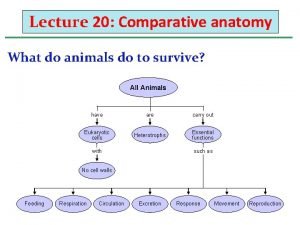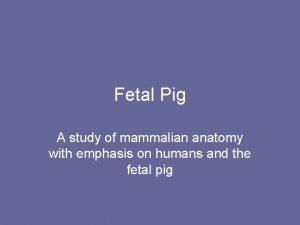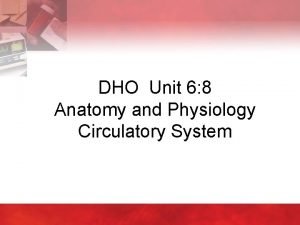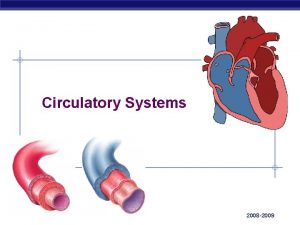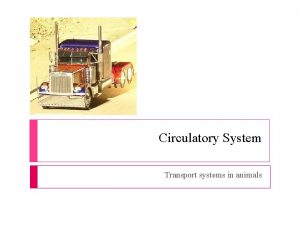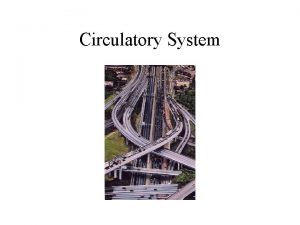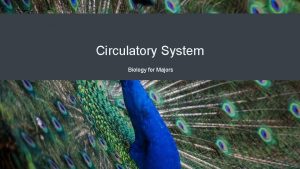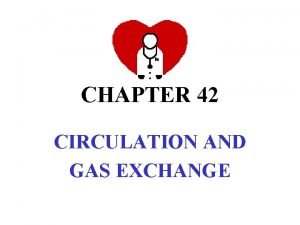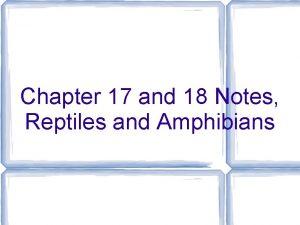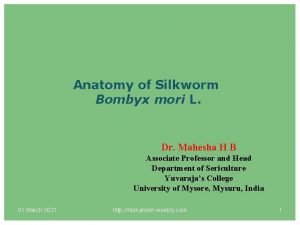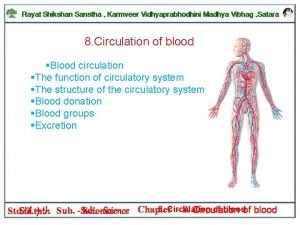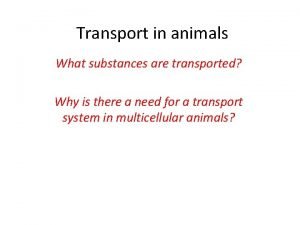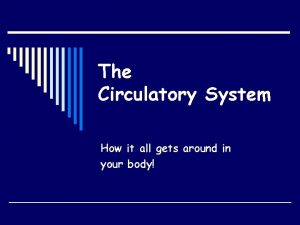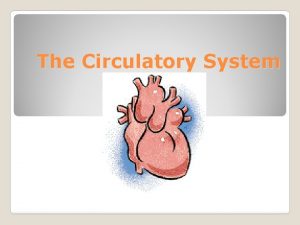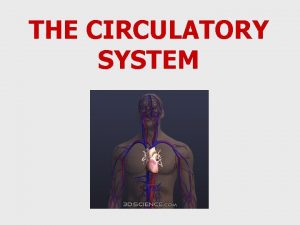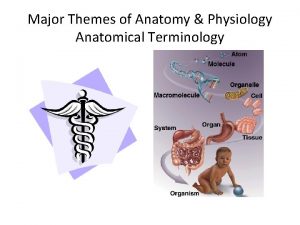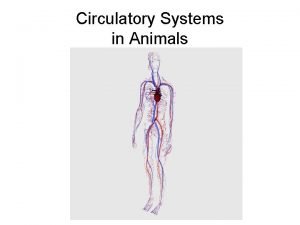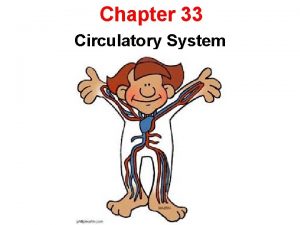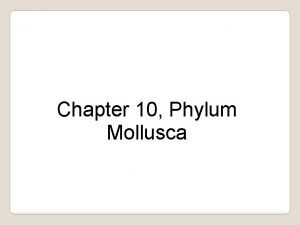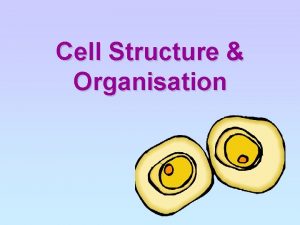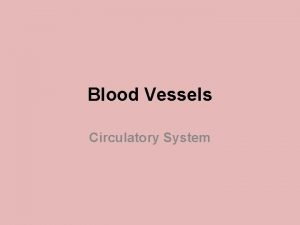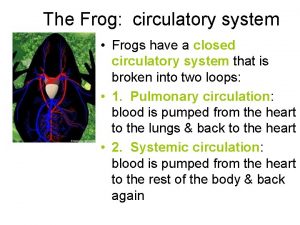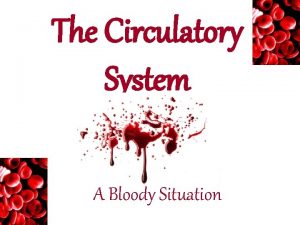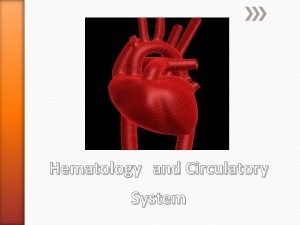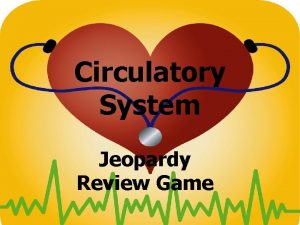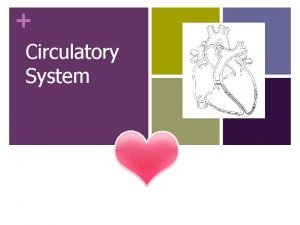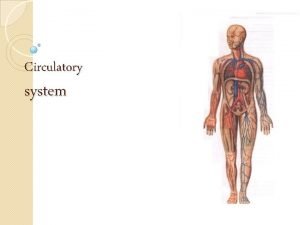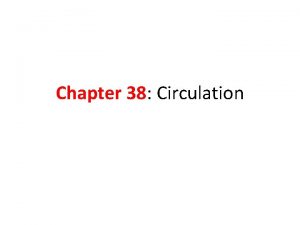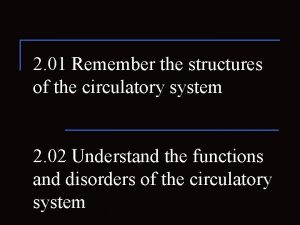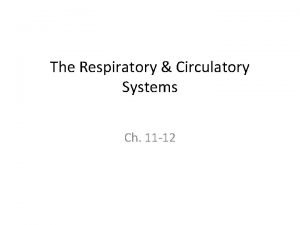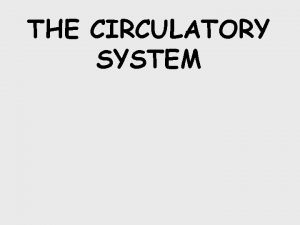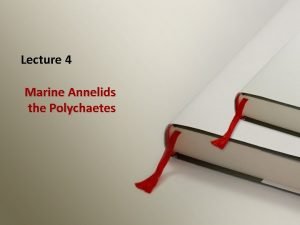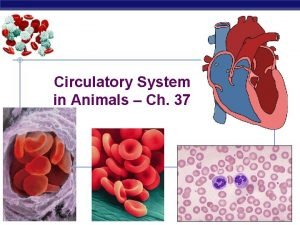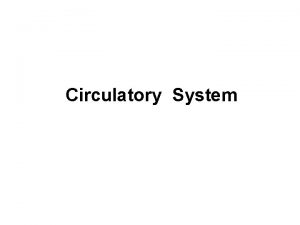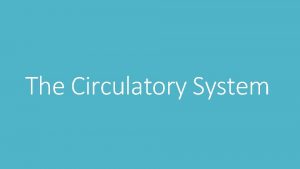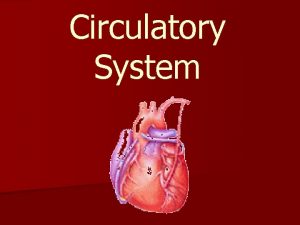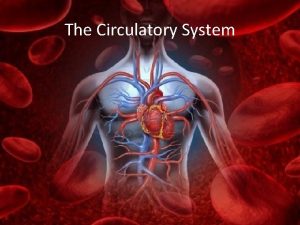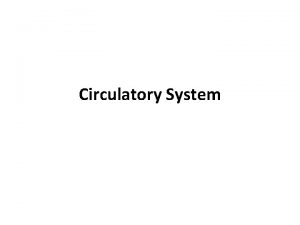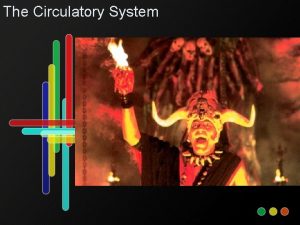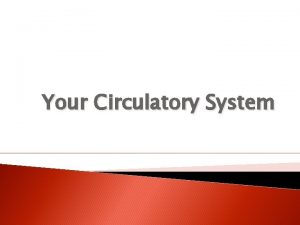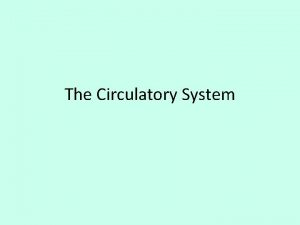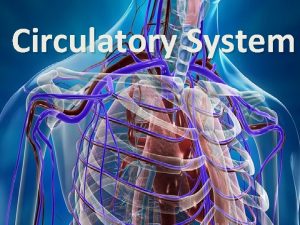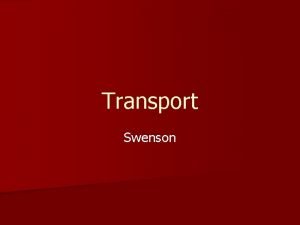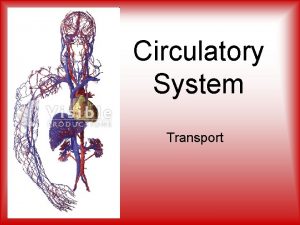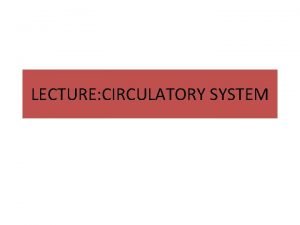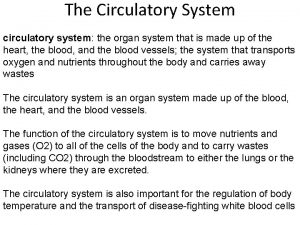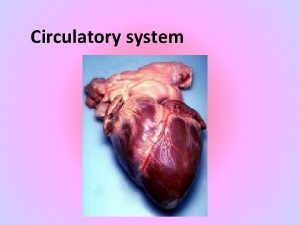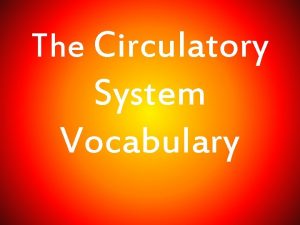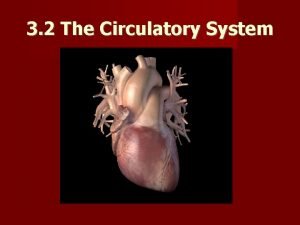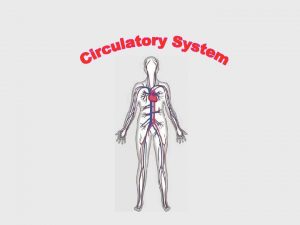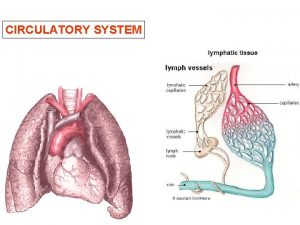The transport system What is the transport circulatory



























































- Slides: 59

The transport system

What is the transport (circulatory) system? Ø It carries blood and dissolved substances to and from different places in the body. Ø The Heart and blood vessels together make up the Circulatory System. Ø The Heart pumps blood and substances around the body in tubes called blood vessels.


to deliver oxygen, nutrients and metabolites to cells The anatomic position of the heart: - chest cavity between the lungs - most of the heart is in the middle, 1/3 on the right side of the heart - apex is on the left side

Blood from the heart gets around the body through blood vessels There are 3 types of blood vessels: a. ARTERY b. VEIN c. CAPILLARY


COMPARE AND DESCRIBE DIFFERENCES AND SIMILARITIES IN ARTERY AND VEIN ANATOMY! adventitia

T A S K D I F F E R E N C E S S I M I L A R I T I E S ARTERY VEIN

The ARTERY Arteries carry blood away from the heart. the elastic fibres allow the artery to stretch under pressure -thick muscle and elastic fibres -narrower lumen than veins the thick muscle can contract to push the blood along.

The VEIN Veins carry blood towards from the heart. veins have valves which act to stop the blood from going in the wrong direction. thin muscle and elastic fibres body muscles surround the veins so that when they contract to move the body, they also squeeze the veins and push the blood along the vessel.




Arteries Pulsating Muscular layer Elastic vasodilation – parasympathetic nerves vasoconstriction - sympathetic nerves Veins Blood flows continuously Thin muscle layer On the surface of the organism VENOUS VALVES (vena cava has none) - pocket valves - three cup shaped flaps


ARTERIAL BLOOD – oxigenated rich with oxygen VENOUS BLOOD poor with oxygen

The CAPILLARY Capillaries link Arteries with Veins Thin and short blood vessels, 8 μm Deliver blood to the cells the wall of a capillary is only one cell thick The exchange of materials between the blood and the body can only occur through capillaries.

The CAPILLARY A collection of capillaries is known as a CAPILLARY BED artery body cell vein capillaries

The human heart


The human heart Pumpes blood ATRIUM VENTRICLE VALVES: ATRIOVENTRICULAR L – BICUSPID R - TRICUSPID VALVE

The human heart VALVES: SEMILUNAR VALVES Where the artery and ventricle are connected Aortic semilunar valve Pulmonary semilunar valve ATRIOVENTRICULAR L – BICUSPID R – TRICUSPID VALVE

Name the structures! vv VENA CAVA, THICK CARDIAC MUSCLE, PULMONARY VALVE, LEFT VENTRICLE, TRICUSPID VALVE, RIGHT VENTRICLE, RIGHT ATRIUM, MITRAL VALVE, AORTA, PULMONARY VEINS, PULMONARY ARTERY, LEFT ATRIUM

http: //i-biology. net/ibdpbio/06 -human-healthphysiology/the-transport-system/


The human heart – outer anatomy http: //www. learnerstv. com/animation. php? ani=321&cat=biology

How does the Heart work? STEP ONE blood from the body blood from the lungs The heart beat begins when the heart muscles relax and blood flows into the atria.

How does the Heart work? STEP TWO The atria then contract and the valves open to allow blood into the ventricles.

How does the Heart work? STEP THREE The valves close to stop blood flowing backwards. The ventricles contract forcing the blood to leave the heart. At the same time, the atria are relaxing and once again filling with blood. The cycle then repeats itself.

http: //www. phschool. com/science/biology_place/biocoach/cardio 1/cycle. html

LABEL WITH CORRECT TERMS: HIGH PRESSURE, HIGHEST PRESSURE, LOWEST PRESSURE

DOUBLE CIRCULATION

http: //www. kscience. co. uk/animations/blood_system. swf



Centers of automation In the heart Manages the work of the heart (centers of automation) 1. SINOATRIAL NODE (S-A node or the PACEMAKER) - The primary center of heart automation - In the right atrium - This is a node in a 70 × min. positively charged, depolarised (Na+ entry through cell membrane) - Action of Na+ / K+ pump (sodium-potassium pump) ejects Na+ so the membrane is negatively charged again, repolarised SA node depolarisation spreads like a wave, and stimulate the muscles Depolarization = contraction


2. ATRIOVENTRICULAR NODE (AV node) - secondary center of heart automation - in the partition between the R atria and R ventricles - continue to transmit stimuli through the conduction pathways (nerves) - electrical stimulus spreads in the surrounding tissue, the electrodes on the chest (properly spaced) receive electrical stimulation Electrocardiograph - device Electrocardiogram (EKG) - recorded electrical potentials

http: //highered. mcgrawhill. com/sites/0072495855/student_view 0/chapter 22/animation__conducting_system_of_the_hear t. html



The heart contracts approximately 70 times× per minute, and then relaxes Systole - contraction Diastole - relaxation Stroke volume (SV) one contraction ~ 70 m. L of blood CHILDREN'S HEART CONTRACTS IN THE FIRST YEAR ~ 130 × PER MINUTE

Stroke volume (SV) one contraction ~ 70 m. L of blood Cardiac output (CO) - the volume of blood being pumped by the heart, in particular by a left or right ventricle, per unit time 70 m. L x 70 = 4900 m. L/min

BLOOD PRESSURE – pressure of blood on vessel walls normal 16/10, 7 k. Pa 120/80 mm. Hg = torr = 133, 322 Pa -sistolic – maximal – upper value - when stroke volume gets to aorta -diastolic – lower -remains after stroke volume passes

BLOOD PRESSURE – pressure of blood on vessel walls normal 16/10, 7 k. Pa 120/80 mm. Hg = torr = 133, 322 Pa -sistolic – maximal – upper value - when stroke volume gets to aorta -diastolic – lower -remains after stroke volume passes

wave height - shows the voltage of the wavelength - time during the process

P - wave - systole (atrium contraction, depolarization) - ventricles in diastole (relaxed) QRS - complex - systole (ventricle contraction, depolarization) - ventricles squeeze blood from the heart T - wave - ventricular relaxation (repolarization)

http: //library. med. utah. edu/kw/pharm/hyper_heart 1. html

Homework http: //i-biology. net/ibdpbio/06 -human-health-physiology/the-transport-system/

http: //www. sympatheticnervoussystem. net/ Controlled by the AUTONOMIC NERVOUS SYSTEM – responds automatically to changes in body conditions

http: //www. rci. rutgers. edu/~uzwiak/Anat. Phys/Blood_Vessels. html http: //www. slideshare. net/fullscreen/gurustip/the-transport-system-core-presentation/16

ADRENALINE (epinephrine) causes increase in heart rate in fight – or – flight responses

PACEMAKER NERVES – stimulation THE MEDULA OF THE BRAIN ADRENALINE (EPINEPHRINE)




FETALNI KRVOTOK Pupčana vrpca – vena, 2 arterije - u DA veći tlak nego u LA - pupčanom venom oksigenirana krv ulazi u DA - nepotpuno pregrađeni atriji – miješa se arterijska i venska krv - foramen ovale – ovalni procijep (primarni i sekundarni septum) - vodi u LA, te u LV te u aortu - veći dio krvi - ductus arteriosus (d. a. Botalli)– povezuje DA i aortu – manji dio krvi - dio u DV - pluća POROĐAJ – presjecanje pupčane vrpce - porast CO 2 u krvi stimulira inspirijsko središte ; prvi INSPIRIJ - tada se poveća tlak u LA i preklope se primarni i sekundarni septum (70% djece) - zatvara se ductus arteriosus

TRANSLATE NEW TERMS! kapilarni tlak – 2, 7 k. Pa venski tlak - ~ 1, 3 k. Pa HIPERTENZIJA (hipertonija) HIPOTENZIJA (hipotonija) INFARKT MIOKARDA – zbog oštećenja koronarnih žila ATEROSKLEROZA – ovapnjenje krvnih žila (kolesterol) TROMBOZA - tromb – ugrušak (nastane zbog prolaza kroz suženje art. ) PLUĆNA EMBOLIJA – embolus (mali putujući ugrušak) se zaustavi u plućima (nema dovoda hranjivih tvari i kisika)

http: //www. nucleusinc. com/animation 2. php http: //www. kscience. co. uk/animations/blood_system. sw f http: //highered. mcgrawhill. com/sites/0072495855/student_view 0/chapter 22/ani mation__conducting_system_of_the_heart. html http: //library. med. utah. edu/kw/pharm/hyper_heart 1. html http: //i-biology. net/ibdpbio/06 -human-healthphysiology/the-transport-system/ http: //www. phschool. com/science/biology_place/biocoa ch/cardio 1/cycle. html
 Site:slidetodoc.com
Site:slidetodoc.com How respiratory system work with circulatory system
How respiratory system work with circulatory system Circulatory system and respiratory system work together
Circulatory system and respiratory system work together Circulatory system steps in order
Circulatory system steps in order Single loop circulatory system
Single loop circulatory system Circulatory system of lungfish
Circulatory system of lungfish Clam open circulatory system
Clam open circulatory system Horse heart
Horse heart Function of the circulatory system
Function of the circulatory system Closed circulatory system
Closed circulatory system Circulatory system job
Circulatory system job 3 parts of the circulatory system
3 parts of the circulatory system Active animals
Active animals How circulatory system work
How circulatory system work What makes up the circulatory system
What makes up the circulatory system Gas exchange oxygen transport
Gas exchange oxygen transport Single circulation and double circulation
Single circulation and double circulation Arthro drama
Arthro drama Crustaceans characteristics
Crustaceans characteristics Open circulatory system vs closed
Open circulatory system vs closed Circulatory system foldable
Circulatory system foldable Invertebrate circulatory system
Invertebrate circulatory system Andometr
Andometr Unit 6:8 circulatory system
Unit 6:8 circulatory system Open circulatory system
Open circulatory system Invertebrate circulatory system
Invertebrate circulatory system Circulatory system function
Circulatory system function Two functions of the circulatory system
Two functions of the circulatory system Arthropods circulatory system
Arthropods circulatory system Difference between open and closed circulatory system
Difference between open and closed circulatory system Chapter 34 circulation in humans concept mapping answer key
Chapter 34 circulation in humans concept mapping answer key Reptile circulatory system
Reptile circulatory system Circulatory system of silkworm
Circulatory system of silkworm Function of the circulatory system
Function of the circulatory system Mass transport in animals
Mass transport in animals Circulatory system interactions with other systems
Circulatory system interactions with other systems Function a
Function a Abo wikipedia
Abo wikipedia Capillary bed
Capillary bed Feed forward mechanism
Feed forward mechanism Functions of the digestive system
Functions of the digestive system Reptile circulatory system
Reptile circulatory system Chapter 33 circulatory and respiratory systems
Chapter 33 circulatory and respiratory systems Mollusca open circulatory system
Mollusca open circulatory system Identify the cell
Identify the cell What are capillaries
What are capillaries Frog closed circulatory system
Frog closed circulatory system Circulatory system
Circulatory system Monkey circulatory system
Monkey circulatory system Circulatory system jeopardy
Circulatory system jeopardy Circulatory system trivia
Circulatory system trivia Circulatory system in a sentence
Circulatory system in a sentence The circulatory system
The circulatory system Where is the femoral pulse located quizlet
Where is the femoral pulse located quizlet Respiratory system quizizz
Respiratory system quizizz Salamander circulatory system
Salamander circulatory system Circulatory system
Circulatory system Circulatory system tissue
Circulatory system tissue Polychaete circulatory system
Polychaete circulatory system Evolution of circulatory system
Evolution of circulatory system



